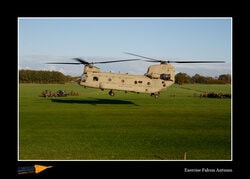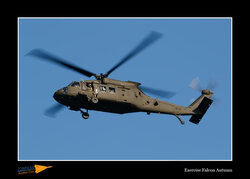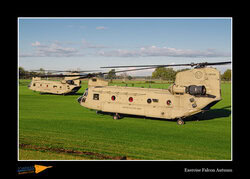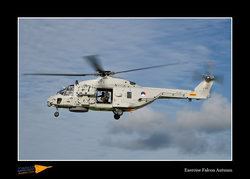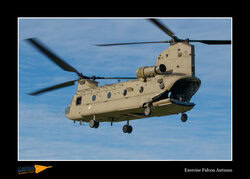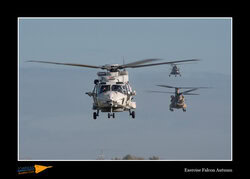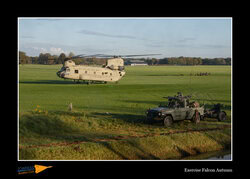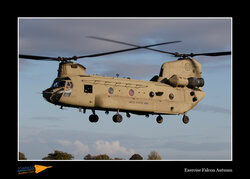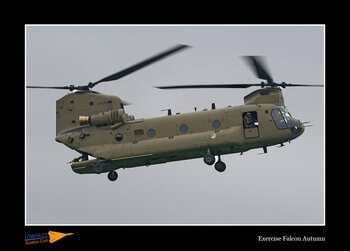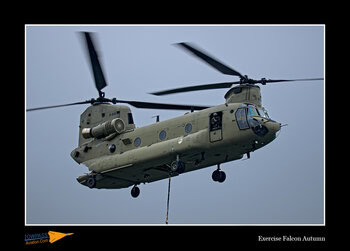Exercise Falcon Autumn
From 31 October till 18 November 2022 exercise Falcon Autumn was held in The Netherlands. During major exercises such as Falcon Autumn, the armed forces train together with other countries to prepare for large-scale airborne operations. The exercise was organized by 11 Airmobile Brigade and the Defense Helicopter Command (DHC). When they work together, they form 11 Air Maneuver Brigade (11AMB). More than 1,000 military personnel and 37 helicopters participated, at various locations in the Netherlands. Participating countries were The Netherlands, Germany, Poland and The United States of America. Germany only participated with military personnel.
The first main task of Defense is to defend Dutch territory and that of allies, for this units must be trained and always ready to fight under war conditions. The Russian invasion of Ukraine makes it clear how important that is and that security and freedom cannot be taken for granted! It’s also important that soldiers from different countries practice together so they interact with each other which is necessary because when there is a real mission they always work together with one or more coalition partners. Practice is the best way to prepare soldiers for real situations and that’s why there are regular, realistic and large-scale exercises. Dutch soldiers often go to training areas abroad but this time exercise Falcon Autumn was hosted by the Netherlands and they showed that they are ready to protect what is dear to us!
For exercise Falcon Autumn various locations in the Netherlands were used including non-military ones to make the exercise as realistic as possible. Locations where training took place in particular were: Ossesluis, Drachten, Malden, Emmen, Balloërveld, Prikkedam, Havelte, De Haar and Valkenburg (South-Holland). All the participating helicopters were during the 3 weeks of the exercise based at former airbase Vredepeel (Luitenant-generaal Bestkazerne).
Assets of the exercise
Low flying: Low-level flying is a means of self-protection for helicopter pilots. They fly low to hide behind obstacles which allows them to carry out their mission unseen and remain outside the radar image of the opponent.
Night vision equipment: During training in night conditions the helicopter crews use advanced night vision goggles to be able to see well in the dark.
Slingery: Transporting external loads by air to provide units in hard-to-reach (mission) areas with equipment and supplies
Trooping: Transporting units by air.
The story: During exercise Falcon Autumn the armed forces practiced protecting NATO territory. A country was attacked and the allies responded, a so-called article 5 scenario, in which allies join forces if one of them is attacked. The airmobile soldiers had to reclaim important territory and chase away the enemy. During the exercise they moved on foot, with light vehicles or by helicopter.
In the first week of the exercise the units mainly practiced working together. They got used to each other and coordinated their working methods. In the air this happened with different helicopters from different countries and then there was the collaboration between helicopters and ground units. The exercises of the first week came together in a great collective mission.
The second week started with a small-scale performance. The units practiced various missions in which soldiers were transported by air and supported on the ground in their attack. Also in the second week the units worked towards a major military mission.
In the third week of the exercise the final piece took place. The units moved to the former airfield Valkenburg for a large-scale operation (air assault).
The Joint action of ground and air units is called air maneuver. There are several forms of air maneuver that could be used during Falcon Autumn:
- Air assault: Offensive operation to, for example, form a bridgehead (deep) in enemy territory. The soldiers use a combination of firepower, speed and the surprise effect. Fighter and transport helicopters and infantry are closely involved in an operation at all times.
- Air attack: The heavily armed Apache combat helicopters have the leading role. Support airmobile soldiers from the ground by, for example, designating targets.
- Air drop (para): Dropping paratroopers and their equipment to carry out tactical assignments directly on the ground.
- Air mobile: Helicopters land directly in a deployment area and drop off personnel.
Air assault (AASLT) is the most difficult and intensive form of air maneuver and the specialty of the airmobile brigade.
Participating squadrons with helicopters:
- Royal Netherlands Air Force: 298 squadron with CH-47F from Gilze Rijen
- Royal Netherlands Air Force: 300 squadron with AS-532U2 from Gilze Rijen
- Royal Netherlands Air Force: 301 squadron with AH-64D from Gilze Rijen
- Royal Netherlands Air Force: 860 squadron with NH-90NFH from De Kooy
- Polish Air Force: 1.Dlot with Mi-8MT and Mi-8T from Leznica-Wielka
- United States Army Europe: A/1-3rd AVN with AH-64D from Ansbach
- United States Army Europe: A/1-214th AVN with UH-60M from Wiesbaden
- United States Army Europe: B/1-214th AVN with CH-47F from Ansbach
Forward Arming and Refuelling Points
During exercise Falcon Autumn several FARPs were used. A forward arming and refuelling point (FARP) or forward area refuelling point is a NATO term for an area where aircraft (typically helicopters) can be refuelled and re-armed at a distance closer to their area of operations than their main operating base. This reduced distance allows a faster turnaround time during sustained operations. FARPs are typically temporary, transitory facilities – particularly if the forward edge of the battle area is highly mobile, or if there is a high threat from enemy aircraft or artillery. The photos below were taken at FARP Charlie, at the Ginkelse Heide. The Ginkelse Heide is Dutch Low Flying Area 4 (GLV4).
The authors of Lowpass Aviation.com would like to thank the PAO of the Luchtmobiele Brigade and all the involved personnel of the Netherlands Air Force for their hospitality, time and help during our visits at multiple training locations.





